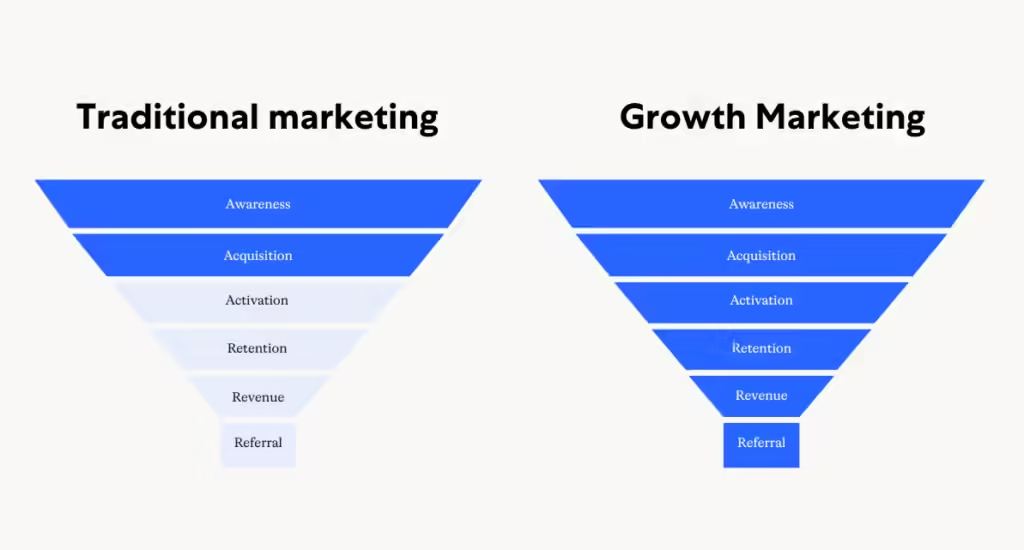Table of Contents
Okay, let’s cut the corporate crap for a second.
If you’re here, you’re probably trying to figure out how to actually grow your brand or business—not just throw ads into the void and hope for the best. You’re done with wasting money on stuff that sounds fancy but does nothing.
That’s where growth marketing comes in.
And no, it’s not just a trendy label.
It’s a way of thinking about marketing that focuses on real growth. Not likes. Not views. Not “going viral.” Just solid, steady results that move the needle.
Let’s break it down—plain and simple, no fluff.
So, What Is Growth Marketing Anyway?
Imagine you’re building a brand. You don’t just want people to notice you once and bounce. You want them to:
- Discover you
- Try your thing
- Stick around
- Tell their friends
- Come back for more
Growth marketing is how you make that happen.
It looks at the whole journey, not just the first click or purchase. It’s about creating an experience people actually want to be part of.
Think of it like dating—you don’t want a one-time swipe right. You want the full relationship.
Why Growth Marketing Feels Different (In a Good Way)
Traditional marketing is like yelling into a crowded room. Growth marketing? It’s like having a real conversation.
Here’s a super quick comparison:
| Old-School Marketing | Growth Marketing |
|---|---|
| “Let’s make a big campaign!” | “Let’s test this idea and see what works.” |
| Focuses on reach | Focuses on results |
| Guesswork | Data-driven |
| One-size-fits-all | Personalized experiences |
| Big spend upfront | Start small, scale smart |
What Growth Marketing Looks Like in Real Life
Even with a lean team and tight budget, this still works. Growth marketing works for startups, creators, local shops—anyone who cares about real results.
Here’s what it usually involves:
Small Experiments
Try two versions of a landing page. Test different email subject lines. Launch a mini-campaign to see what sticks. You can start small and still make a big impact.
Follow the Data
See what people are clicking, buying, ignoring. Use that info to tweak and improve. Numbers don’t lie—guessing does.
Fix What’s Broken
If your sign-up page confuses people, fix it. If nobody opens your emails, change the tone. Growth marketing is about removing friction and making things better bit by bit.
Work Across Teams
It’s not just a marketing job. Your designer, developer, support team—they all play a role. Everyone contributes to growth.
Real Growth Marketing Tactics (That Don’t Feel Gross)
Let’s get specific. Here’s stuff that actually works—tested by people who don’t have time to waste:
1. Make Referrals a No-Brainer
If someone loves your product, they’ll talk about it. Make it easy (and rewarding). “Share the love, save some cash. 20% off for both of you.”
2. Fix That Awkward First Step
Your onboarding, sign-up, or first purchase experience shouldn’t feel like a chore. A quick walkthrough or “Welcome” email can make people feel like they’re in the right place.
3. Send Emails That Sound Human
No more “Dear Valued Customer.” Write like a person. “Hey, saw you checked this out but didn’t grab it—still interested?” Works way better than a robotic blast.
4. Create Genuinely Helpful Content
If you’re just writing blogs to rank on Google, people can tell. Instead, create stuff that actually helps your audience. Tips, guides, tools, stories. Be useful.
5. Tweak Constantly
That red button isn’t converting? Try blue. That headline not getting clicks? Rewrite it. Small changes = big wins over time.
A Quick Growth Marketing Example
Let’s say you’re selling a meal plan subscription:
- Attract – Run a Reel showing how easy your meals are
- Hook – Offer a 3-day free trial with no strings
- Welcome – Send a super friendly “How it works” email
- Keep Engaged – Weekly recipes, helpful cooking tips
- Grow – Ask happy users to refer a friend for a free box
That’s growth marketing. Easy to follow. Easy to scale.
Tools That Make It Easier
You don’t need fancy tools, but these can help:
- ConvertKit / Klaviyo – Emails that don’t suck
- Hotjar – See where people get stuck on your site
- Zapier – Connect your tools so you don’t lose your mind
- Google Analytics – The basics, still important
- Canva / Notion / Buffer – For content, planning, scheduling
Most of these are free or cheap to start. Use what helps—ditch what doesn’t.
What You Should Actually Track
Growth marketing isn’t about vanity metrics. These are the ones that matter:
- Conversion rate (are people actually doing the thing?)
- Customer lifetime value (do they stick around?)
- Churn rate (how fast are they leaving?)
- Referral rate (are they telling others?)
- Revenue (because yeah, that matters too)
If a tactic doesn’t move at least one of these metrics, question it.
Final Thoughts: You Don’t Need to Be a “Marketing Guru”
Here’s the real deal: you don’t need to be an expert or have a giant team.
Growth marketing works best when you:
- Care about your customer
- Stay curious
- Aren’t afraid to test stuff
- Pay attention to what actually works
Start small. Pick one thing to improve. Try something new this week. Track it. Learn from it.
Then keep going.
That’s growth marketing. No buzzwords. Just better business.

